|
BULB LOG 40 --- 30th September 08

Fritillaria house
I have now got the Fritillaria house ready to be watered but most of them have not been repotted. As most of them were done last year I just picked out the ones that were not done since 2006.
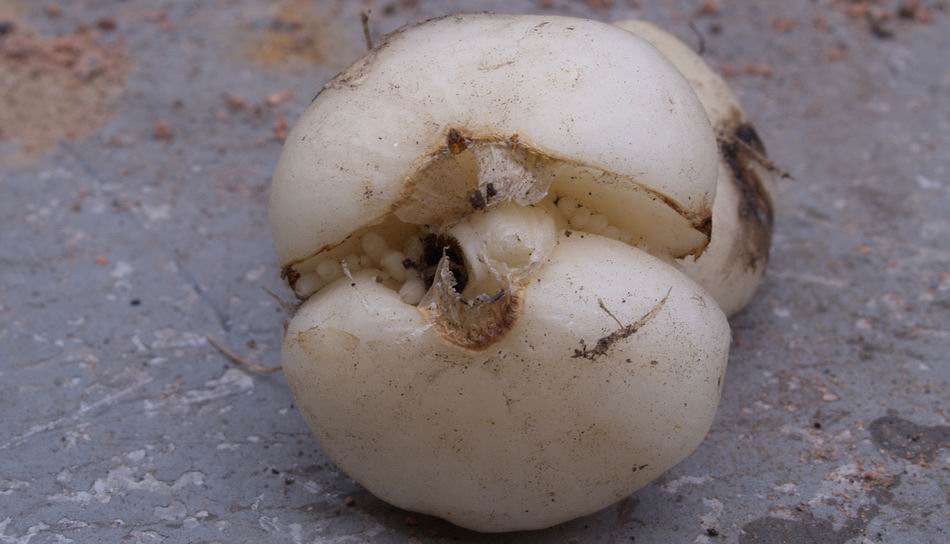
Fritillaria hermonis amana bulb with rice growing
I am still using the old name of Fritillaria hermonis amana for many of our pots rather than the recently reintroduced names of F. hermonis or F. amana because I have not marked up some of them when they were flowering and also some are seed raised and appear intermediate anyway. However the reason for showing this picture is to point out to you that even though the bulb has received no water it is already starting to grow by producing rice grains in between the scales.
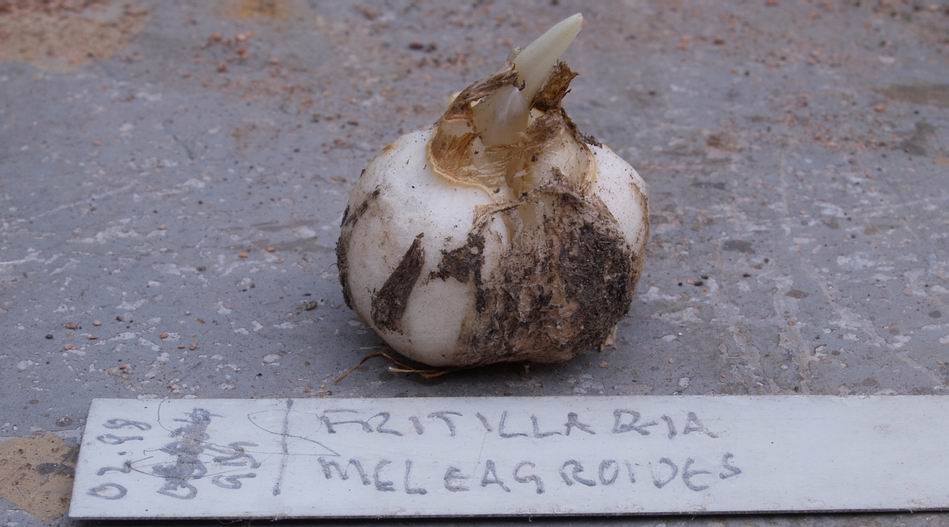
Fritillaria meleagroides bulb
In the past I have always started my frits at the same time as the other bulbs on the first of September but over the last five years I have been experimenting. I am in no doubt that frits wake up from their summer dormancy later than say Crocus and Narcissus do and now I have worked out that they are behind by about four weeks. I showed dry Narcissus bulbs in late August with the root tips already extending indicating they were looking for moisture but there was no sign of any activity on the frits - now one month on there is. You can see that the shoot on this Fritillaria meleagroides bulb is well extended indicating to me that it is time to give them a good soaking.
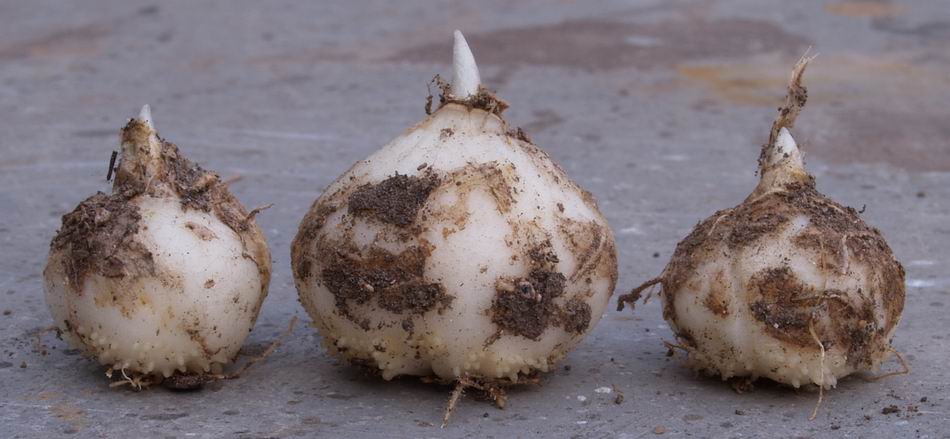
Fritillaria michailovskyi bulbs with shoots and roots
Like wise these Fritillaria michailovskyi bulbs have extended shoots but also look at the base and you will see the root tips also extending.

Fritillaria bulb roots
Look carefully at the base of these bulbs and you will see a ring of roots emerging. The reason I have been experimenting to find the optimum time to give the frits their first storm is to reduce the loss of bulbs to wet rot caused by a still dormant bulb having to sit in wet compost for four weeks. It is easy for me to regulate in this way as there are mostly only frits in the frit house but I also have other pots of frits in the bulb houses and they were all watered four weeks ago so it is not essential to water them later but it is better if you can. As always these are the timings for our climate - if you are in a warmer area then your bulbs will wake up that bit later. Another point that has always bothered me is that we are told that frits are bulbs, not a true bulb like say a Narcissus but bulbs never the less. Now to be a bulb the scales must be modified leaves and as you can see the roots emerge towards the outer perimeter of the base of the scale - so is that a modified leaf or a stem? A true bulb w
ith modified leaves builds on itself each year by adding layers while a true corm- a swollen modified stem, replaces itself completely every year - a fritillaria replaces itself every year. I think that while it is easy to say a narcissus is a true bulb and a crocus is a true corm it is too simplistic an approach to try and lump all the other 'bulbs' we see into these categories because to my mind many of them are a combination of the two.
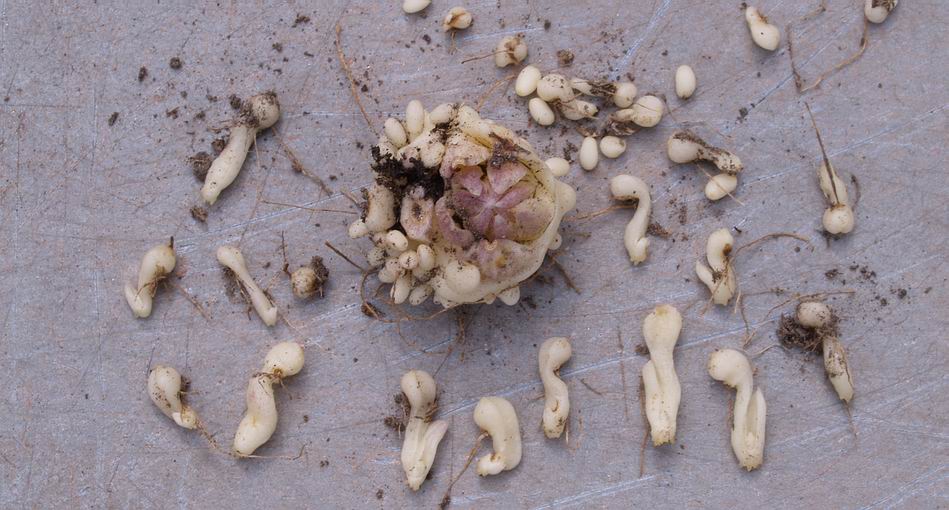
Fritillaria recurva bulbs
I have believed for a long time that the North American rice grain fritillaria 'bulbs' are part compressed stem and part modified leaf. A wise man once told me that you need two lives to be a good gardener, one to learn and one to do. I think that I will need more than one life time to learn all there is about bulbs. I had been coming to a conclusion that in general these American disc shaped bulbs preferred to be planted nearer the surface. However this picture gives strong clues that that is not always the case.
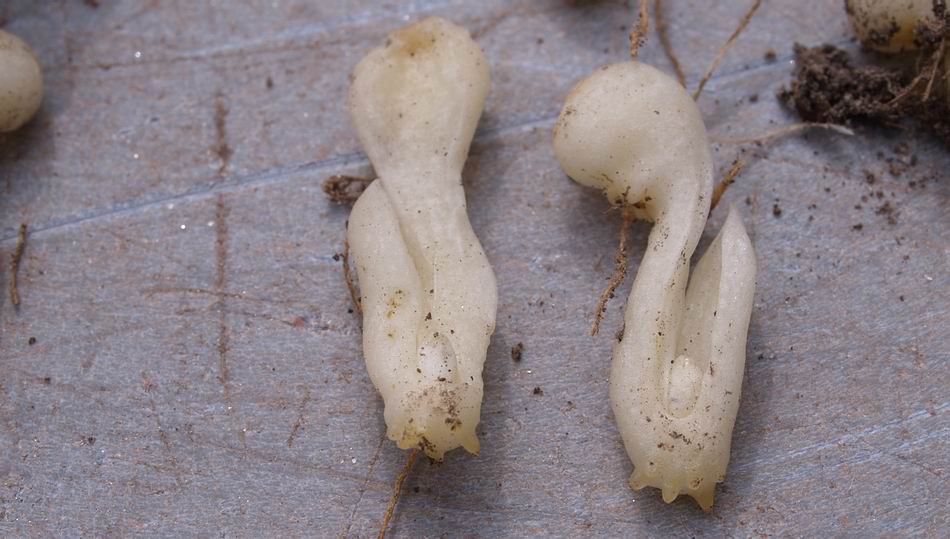
Fritillaria recurva bulbils with root tips
A close look at some of the bulbils shows clearly that they are elongating to take them selves deeper into the compost. Again I conclude that it is too simplistic to say that a bulb always prefers to be planted at a certain depth. What the bulb is looking for is a certain temperature and moisture level and it will try to take itself to the depth where it might find those parameters. For instance in a very hot summer a bulb might try and go deeper while in cold and damp conditions that same bulb may try and climb upwards in the soil. As growers we have to achieve a happy medium because happy bulbs make for happy growers. Also notice that the root tips are extending on these juvenile bulbs.

Fritillaria bulbs and seedlings
I have shown you in the past that to save space I often sow the seeds back in the same pot with the adult bulbs. This is a good example of the result at the first repotting two years after the seed was sown.

Fritillaria storm
So as we approach the end of September I have given the frits their first storm taking care to apply plenty water to make sure that the pots are soaked evenly through out.
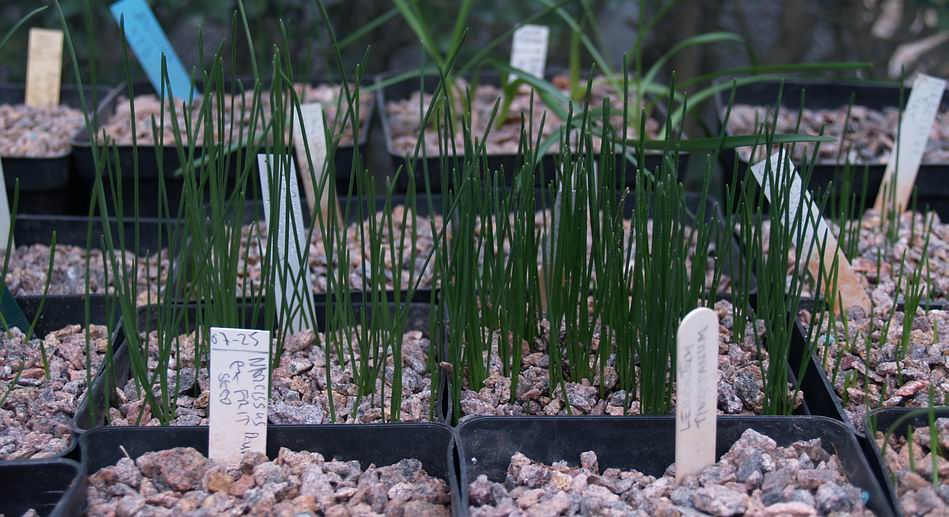
Narcissus leaves
There is a lot of leaf growth appearing on the Narcissus now and they will get their second storm on the first of October. Also remember to watch out for any signs of aphids on the emerging leaves and take the necessary action. If you catch them in time they can be easily controlled by wiping them out with your fingers but if the infestation is too big then spray with a systemic insecticide.
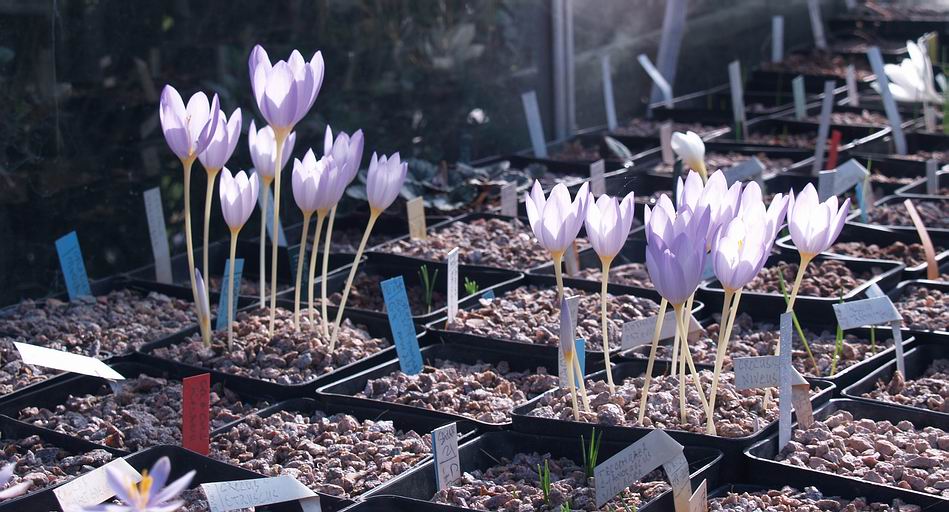
Crocus kotschyanus
Many crocus are flowering in the bulb house now like these two pots of Crocus kotschyanus.
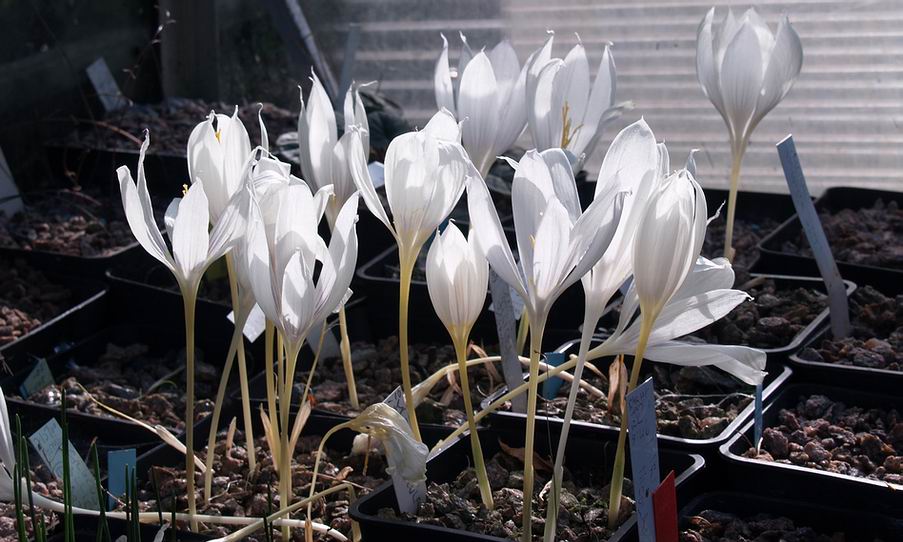
Crocus vallicola
Crocus vallicola continues to flower as many corms send up a second flower after the first one has faded. As I mentioned before these are only under glass while they flower to prevent them being at the mercy of the inclement weather and to increase the chance of getting a good seed crop.
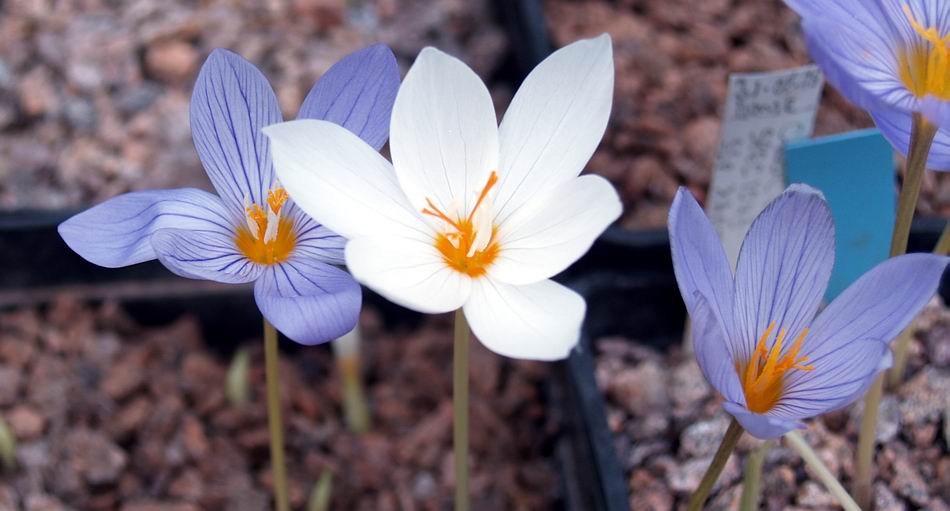
Crocus pulchellus albus and others
Talking of seedlings; in the centre is Crocus pulchellus albus and on the right is C. speciosus ssp xantholaimos and on the left I think is a hybrid between the two.
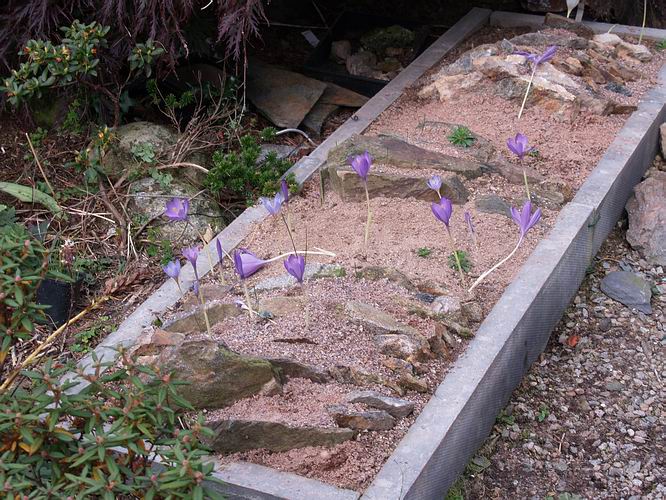
Experimental bed
Outside in the experimental sand plunge bed I constructed last year to provide a home for all the stray bulbs, corms and tubers that I have Crocus nudiflorus, pulchellus and kotschyanus, are all in flower.
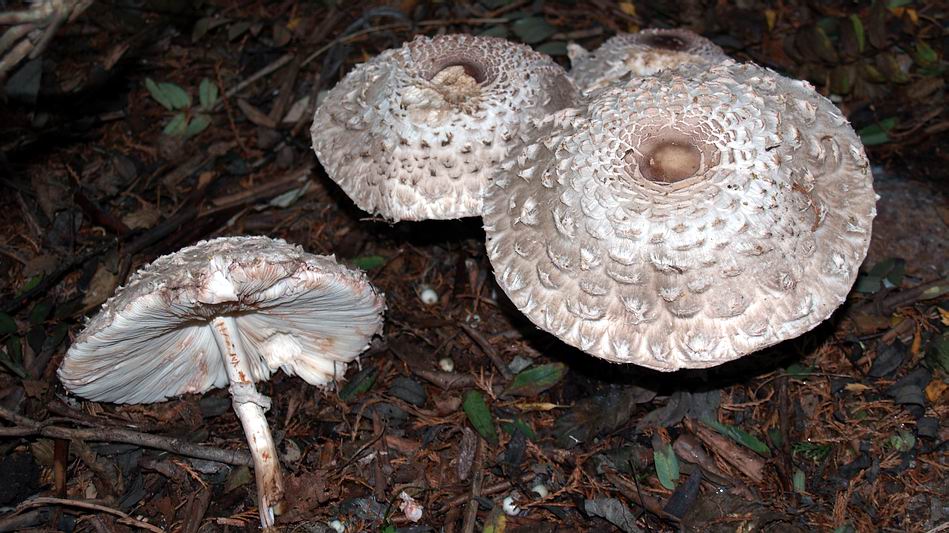
Fungi in the garden
And now for something completely different to end with - up by our compost heaps are some very fine stands of shaggy parasols.
^ back to the top ^
|

